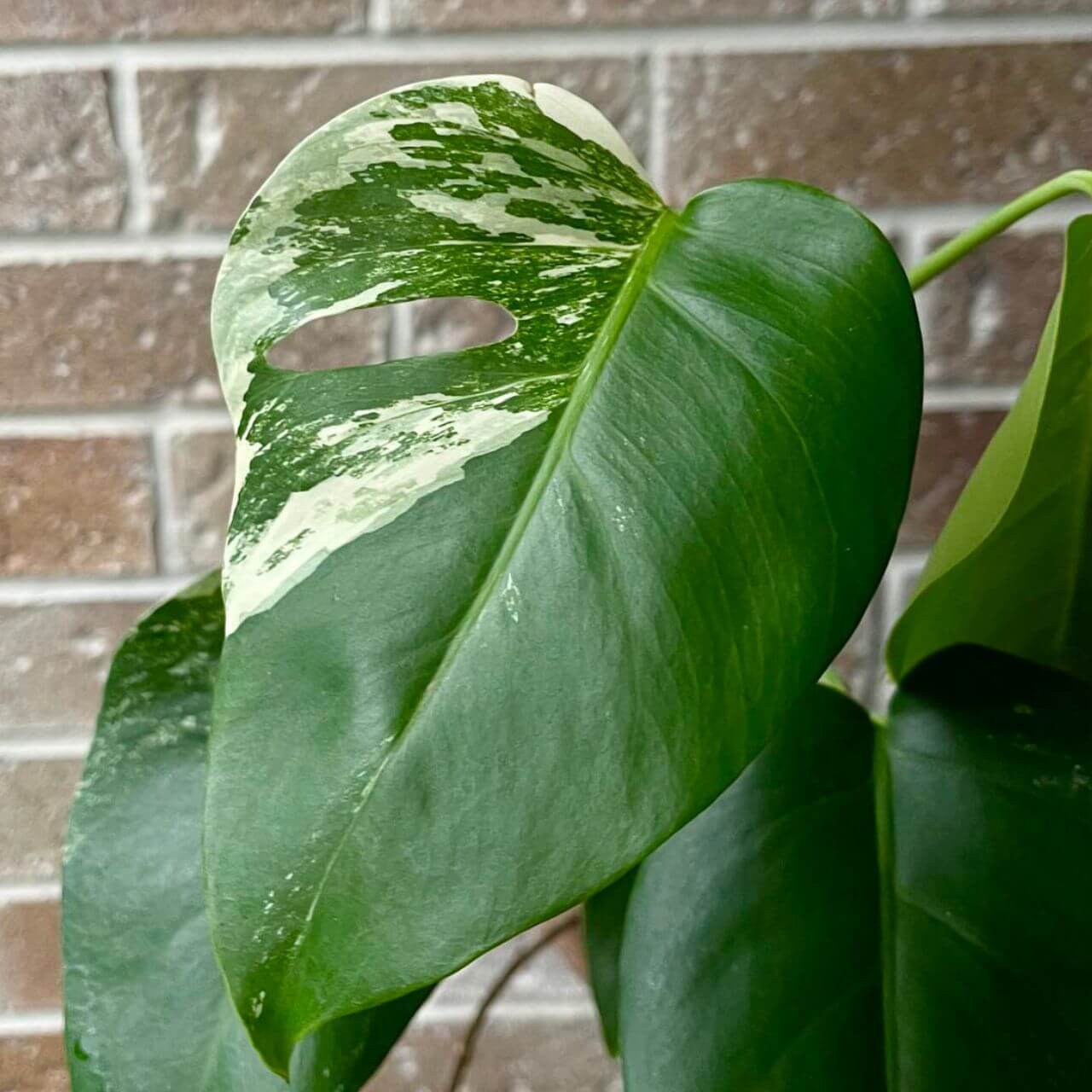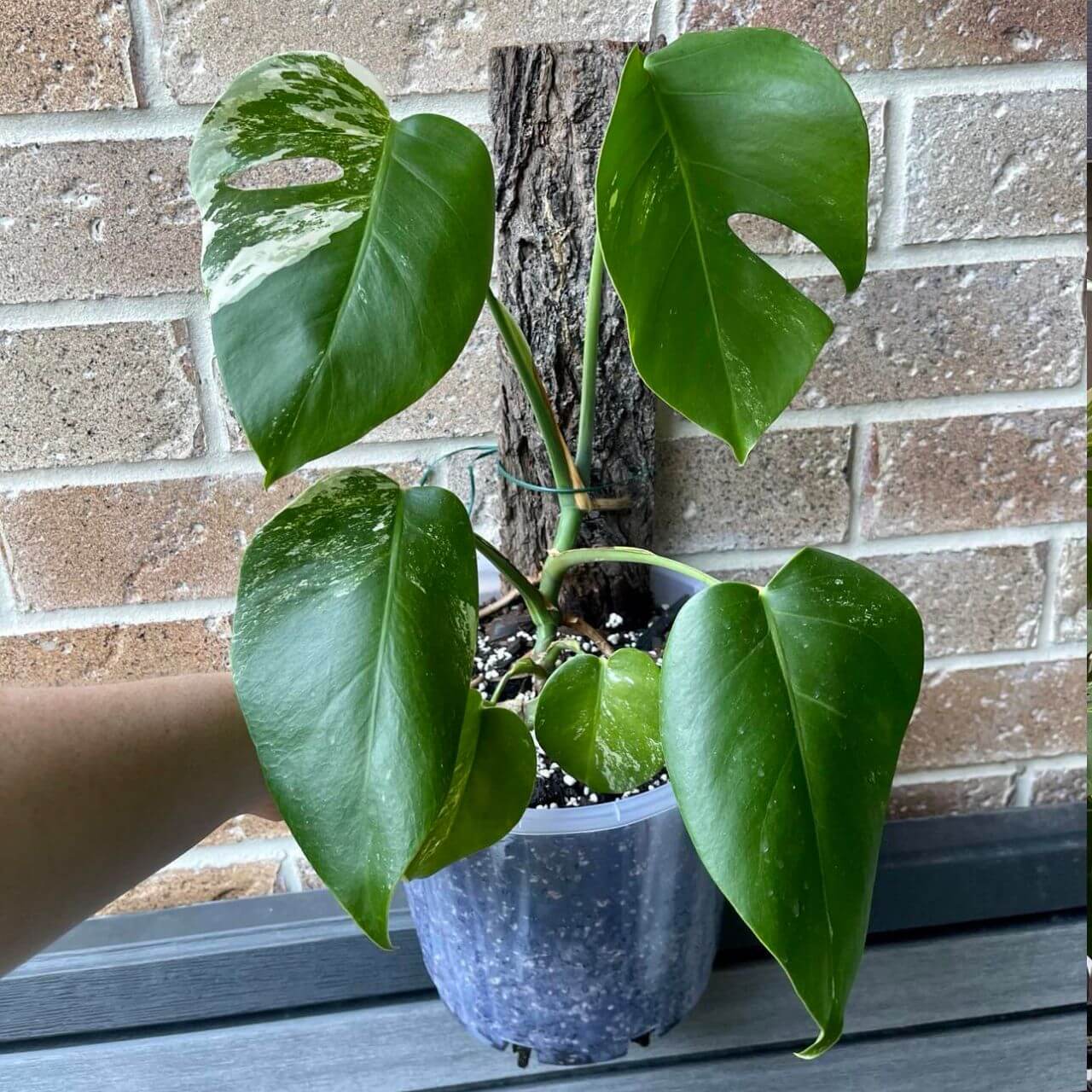Monstera Borsigiana ‘Albo’ are a rare variegated variety of Monstera which are extremely similar in appearance and shape to Monstera Deliciosia & Thai Constellation Monstera.

Monstera Borsigiana ‘Albo’ Quick Care Overview
| Care Aspect | Requirements |
|---|---|
| Scientific Name | Monstera Deliciosa ‘Albo Borsgiana’ |
| Light | Bright indirect light |
| Temperature | 65-80ºF (18-27ºC) |
| Humidity | Above 60% |
| Watering | Allow top 1-2 inches of soil to dry |
| Fertilizing | Monthly with a balanced liquid fertilizer |
| Soil | Rich, well draining soil |
| Repotting Frequency | Every 2-3 years |
| Propagation Method | Stem cutting |
| Common Pests & Diseases | Spider Mites, Scales Mealybugs, Fungus Gnats, Thrips and root-rot |
| Toxicity | Toxic to humans and pets |
Identifying Monstera Borsigiana ‘Albo’
With vibrant white and light green variegation contrasting the dark green leaf, Monstera Borsigiana are easy to identify with this distinct coloration of their fenestrated leaves.
Below is a reference image of a young plant developing its unique color pattern on its leaves.

Size
Similar to the Monstera Deliciosa, Monstera Albo can reach sizes of 25cm to 90cm long and 30cm wide. With most typical plants kept indoors reaching around 8 feet in length at full maturity.
Light Requirements
To help keep stable variegation on your Monstera Albo, it needs a spot where it receives bright, indirect light. It’s important to keep this plant away from direct sunlight as it will scorch the delicate leaves.
A sign that your Monstera Albo isn’t receiving enough light is if the new leaves start losing the variegation. This plant requires bright filtered light to keep those beautiful variegated leaves.
Adding a blind or curtain to a spot that receives direct sunlight will help defuse the harsh light and help avoid burning the leaves. Grow lights are a good alternative if your plant requires more light.
The same as direct sunlight, grow lights can burn the plants leaves if the light is sitting too close to the plant. A safe distance of approximately 60cm should be kept between the plant and the light to avoid any issues.
Temperature Requirements
Monstera Albo love warm temperatures and will thrive when kept between 65-80ºF (18-27ºC). Ensure this plant is kept away from cold drafts, air vents and/or extreme temperature changes as this can damage the plants foliage.
Humidity Requirements
Monstera Albo will thrive when kept in an environment that is above 60% humidity. Keeping this plant in a humid environment will help keep foliage vibrant and encourage faster growth. Crispy browning leaves can be an indication of not enough humidity.
Providing humidity for your plants can help encourage larger and healthier growth. If you’re needing to boost the humidity in your home, you can try misting your plants, have a pebble tray with water, group your plants together, use a humidifier and/or use a greenhouse.
Watering
Water your Monstera Albo once the top 1-2 inches of soil is dry. The frequency of this will depend on the type of soil mix you use, the climate and the season. During the colder months, you won’t need to water as often as in the warmer months because the soil won’t dry out as fast.
Before watering your plant, you should check the soil to see if it needs water. The Monstera Albo is susceptible to root rot and it’s better that the soil dries out instead of being wet and soggy.
Drooping, yellowing and/or browning leaves can be a sign of under-watering, over-watering and/or root rot.
You need to be cautious of over-watering your plant. Excess water to the soil can cause it to become waterlogged, which causes root rot, pest problems and other fungus issues. Rotted roots can no longer provide for the plant and if left untreated, can cause plant death.
It’s important to use a well draining soil and pots with drainage to help avoid the issue of over-watering. After watering your plants, always check to make sure they aren’t sitting in water.
Fertilizing Monstera Borsigiana ‘Albo’
Monster Albo aren’t heavy feeders and will only require fertilizing once a month during the growing period (spring and summer). Fertilizing isn’t needed during the cooler months when the growth slows and the plant isn’t actively using the nutrients in the soil.
A balanced all purpose fertilizer diluted to half strength is the best type to use to feed your Monstera Albo. If you can, try and avoid cheap fertilizers that are high is salts. This can damage the roots and as a result, damage the plants foliage.
Fertilizing your plants gives them the essential nutrients they need to grow and maintain new and healthy growth. It’s important to avoid fertilizing your plants when they aren’t actively growing and using the nutrients in the soil because this can cause salt build up and root burn.
Every couple of months you should try and flush the soil to prevent mineral salt build up. Run water through the soil for 1-2 minutes to help clean out any excess fertiliser and salts. White crusts on the soil can be a sign of too much fertiliser.
You need to be cautious of over-fertilizing your plant. Over-fertilizing your Monstera Albo can result in foliage and root burn. To help clean out some of the excess fertilizer, you can rinse the soil with water or completely repot into a fresh mix of soil.
Common Monstera Borsigiana ‘Albo’ Diseases & Pests
The common houseplant pests that you can see on your Monstera Albo are spider mites, thrips, scale and mealybugs. The most common diseases you could see are brown leaf spots and root rot.
When caring for indoor plants, pest prevention is the best thing you can do. Keeping happy and healthy plants will give you the best shot at avoiding most pests but most importantly, healthy plants can handle and come back from any pest infestations more easily than plants that are already unhappy.
Some of the things you can do to help prevent pest infestations from starting are:
- Check new plants for pests and isolate them for up to a week before introducing them into your collection.
- Check current plants for signs of pests at least once a week.
- Prune off dying and dead leaves.
- Clean leaves frequently to avoid a build up of dust and/or dirt.
- Isolate any pest infested plants.
Following these frequently will help you catch any pests early on and avoid any infestations from having the chance to start.
Soil & Potting Requirements
Monstera Albo grow best in a rich, well draining soil. Using a mixture of orchid bark, perlite, coco chips and coco coir will create drainage and aeration, as well as retain moisture. You can also add worm castings to the mix to provide extra richness.

Oxygen and aeration is important in a soil mix because that’s what allows the plants roots to breathe. Not enough oxygen in the soil is the main factor to rotting roots. You can also add charcoal, pumice and/or vermiculite to the mixture to help improve drainage, aeration and water retention.
You also want to make sure your Monstera Albo is potted into a pot that has drainage holes. Using pots with drainage paired with a well draining soil will help in avoiding root rot.
With the Monstera Albo being quite slow growing, it won’t need to be repotted too frequently. When repotting, you should do it during the warmer months (spring and summer) and use a pot that is 2-3 inches larger than its current pot. A sign that your Monstera Albo might need repotting is when you start seeing roots protrude from the bottom of the pot.
Propagating Monstera Borsigiana ‘Albo’
The easiest and only way to propagate a Monstera Albo is by stem cuttings. For a stem cutting to work, you need to make sure you take a cutting that has at least one node. A node is where the leaf attaches to the stem and where new growth will grow from.
The propagation can be grown in a variety of different mixtures. These include perlite, water, sphagnum moss, soil or LECA. Monstera Albo propagations can take quite a lot of time to compared to the regular Monstera Deliciosa to root and grow.
